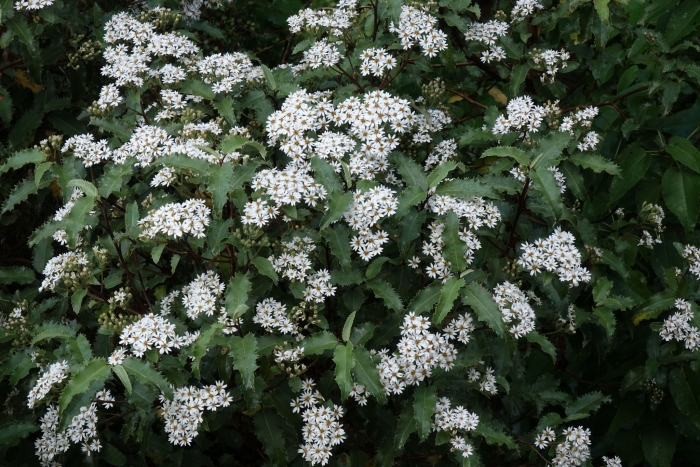Maori-Holly
(Olearia ilicifolia)
Maori-Holly (Olearia ilicifolia)
/
/

John Barkla
CC BY 4.0
Image By:
John Barkla
Recorded By:
Copyright:
CC BY 4.0
Copyright Notice:
Photo by: John Barkla | License Type: CC BY 4.0 | License URL: http://creativecommons.org/licenses/by/4.0/ | Rights Holder: John Barkla | Publisher: iNaturalist | Date Created: 2020-01-06T07:33:19-08:00 |



















































Estimated Native Range
Summary
Olearia ilicifolia, commonly known as Maori-Holly, is an evergreen shrub native to the forest margins, subalpine scrub, and tussock grasslands of New Zealand. It is a much-branching, spreading shrub that can also take the form of a small tree, typically growing 1.5–4.6 meters (4 ft 11 in – 15 ft 1 in) tall. The leaves of Maori-Holly are 5–10 centimeters (2.0–3.9 in) long and 1–2 cm (0.39–0.79 in) wide, with undulating and coarsely serrated margins, presenting a greyish-green coloration on the upper surface. Its flowers are particularly showy, with white petals surrounding yellow centers, blooming in large terminal corymbs that add ornamental value to the plant.
Maori-Holly is valued for its attractive foliage and showy flowers, which can enhance garden borders and provide a dense, textured appearance. It is also used for creating informal hedges and screens in cultivation. This shrub is relatively easy to maintain, requiring full sun exposure and medium amounts of water. It thrives in soils with medium drainage and is tolerant of a range of soil types, including those that are somewhat poor or rocky. While it is generally disease-resistant, it can occasionally suffer from root rot if overwatered or planted in poorly drained soils. Maori-Holly is not known for aggressive roots or significant pest problems, making it a reliable choice for gardeners. It is also noteworthy for its adaptability to coastal conditions, making it suitable for seaside plantings.CC BY-SA 4.0
Maori-Holly is valued for its attractive foliage and showy flowers, which can enhance garden borders and provide a dense, textured appearance. It is also used for creating informal hedges and screens in cultivation. This shrub is relatively easy to maintain, requiring full sun exposure and medium amounts of water. It thrives in soils with medium drainage and is tolerant of a range of soil types, including those that are somewhat poor or rocky. While it is generally disease-resistant, it can occasionally suffer from root rot if overwatered or planted in poorly drained soils. Maori-Holly is not known for aggressive roots or significant pest problems, making it a reliable choice for gardeners. It is also noteworthy for its adaptability to coastal conditions, making it suitable for seaside plantings.CC BY-SA 4.0
Plant Description
- Plant Type: Shrub
- Height: 5-9 feet
- Width: 5-9 feet
- Growth Rate: Moderate
- Flower Color: White
- Flowering Season: Summer
- Leaf Retention: Evergreen
Growth Requirements
- Sun: Full Sun
- Water: Medium
- Drainage: Medium
Common Uses
Bee Garden, Butterfly Garden, Drought Tolerant, Fragrant, Low Maintenance, Salt Tolerant
Natural Habitat
Forest margins, subalpine scrub, and tussock grasslands of New Zealand
Other Names
Common Names: Mountain Holly, Hakeke, Hākēkeke, New Zealand Holly
Scientific Names: , Olearia ilicifolia, Olearia mollis, Aster ilicifolius, Aster multibracteolatus, Eurybia dentata, Eurybia dentata var. linearifolia, Olearia multibracteolata, Shawia dentata,
GBIF Accepted Name: Olearia ilicifolia Hook.fil.